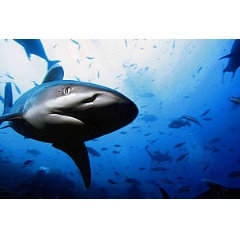First practical guide to protected areas for sharks and rays launched
WWF and the Centre for Sustainable Tropical Fisheries & Aquaculture (CSTFA) at James Cook University have launched the first-ever Marine Protected Areas (MPAs) guide specifically aimed at sharks and rays.

“A Practical Guide to the Effective Design and Management of MPAs for Sharks and Rays” provides science-based advice on developing and maintaining MPAs for these species, which are increasingly threatened with extinction. The 52-page guide helps maximize the impact of spatial protection by outlining how to ensure the areas are well designed, implemented, managed and enforced for the long term.
The plight of sharks and rays is worsening. A quarter of all species are threatened with extinction based on the IUCN Red List, with overfishing the biggest threat to their survival. The approximately 1,150 species of sharks and rays provide a wide array of crucial ecosystem functions, intertwining these creatures with the health of our oceans and the people who depend on them.
The guide builds on the most comprehensive global analysis to date of the effectiveness of shark-focused MPAs, as well as a review of known information on the movement of sharks.
“MPAs have become a popular tool to try and address some of the conservation challenges that sharks and rays face; however our research suggests that globally many are not providing positive benefits,” said guide co-author Colin Simpfendorfer, a Professor in the College of Science and Engineering at James Cook University. “To be effective, MPAs for sharks and rays need clear goals, objectives and conservation targets, while incorporating scientific knowledge on shark movement patterns, ecology and habitat use alongside socioeconomic and cultural considerations.”
Dr. Andy Cornish, Leader of the WWF’s Sharks: Restoring the Balance initiative, said, “Losing sharks undermines ocean ecosystems and deprives coastal communities of income and livelihoods, including tourism opportunities. Effective spatial protection of critical habitats is one of the most practical ways to reduce fishing mortality of sharks and rays, with potential benefits spanning improved fisheries management to the conservation and recovery of threatened species.”
Besides fisheries managers, the MPA guide is aimed at authorities responsible for marine habitat and species protection, Regional Fishery Management Organizations, NGOs and other MPA practitioners working to conserve sharks and rays, as well as marine tourism operators.
The guide’s aim of helping global efforts to halt the decline of sharks and rays, prevent extinctions and put measures in place to allow recoveries by 2025 is in line with the goal of the Global Shark and Ray Initiative’s (GSRI) global conservation strategy. Find out more at https://sharks.panda.org/about-us/global-sharks-and-rays-initiative
WWF and James Cook University would like to thank the Shark Conservation Fund for its financial support of the James Cook University-led project, ‘Maximising outcomes for shark and ray MPAs’, that contributed significantly to the production of content for this guide. Thanks also to the project’s partner institutions – the Australian Institute of Marine Science, the University of Queensland and Simon Fraser University – and to the project team for their input, comments and thoughts.
###
The Guide is available here: https://sharks.panda.org/tools-publications/marine-protected-areas
Sharks: Restoring the Balance is a partnership between WWF and wildlife trade monitoring network TRAFFIC, which supports teams working across 11 countries. https://sharks.panda.org/.
WWF’s Dr Cornish has written a blog on the value and importance of MPAs. You can read it here:
https://medium.com/@WWF/why-we-need-more-protected-areas-to-conserve-sharks-and-benefit-people-551bc0a08852
Notes: MPAs are areas designated and managed to protect marine ecosystems, processes, habitats, and species that can contribute to the restoration of resources for social, economic, and cultural enrichment.
------
About WWF
WWF is one of the world’s largest and most respected independent conservation organizations, with more than 5 million supporters and a global network active in over 100 countries. WWF’s mission is to stop the degradation of the earth’s natural environment and to build a future in which humans live in harmony with nature, by conserving the world’s biological diversity, ensuring that the use of renewable natural resources is sustainable, and promoting the reduction of pollution and wasteful consumption.
www.panda.org/media for latest news and media resources
About CSTFA
Research within James Cook University’s Centre for Sustainable Tropical Fisheries and Aquaculture (CSTFA) focuses not only on the aquatic and aquaculture systems that produce food, but also the industries and communities that utilise them. Multidisciplinary collaborations between our researchers provide the synergies to address substantial research problems in a way that individual research groups cannot. The CSTFA provides research outputs for sustainable food production to local, state, federal and international resource managers, both in government and in the private sector. Thus, making us a key player in helping secure aquatic food production in the tropics for future generations https://www.jcu.edu.au/tropical-fisheries-and-aquaculture
( Press Release Image: https://photos.webwire.com/prmedia/6/240749/240749-1.jpg )
WebWireID240749
This news content was configured by WebWire editorial staff. Linking is permitted.
News Release Distribution and Press Release Distribution Services Provided by WebWire.